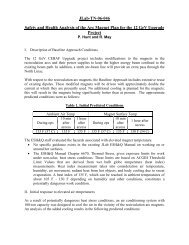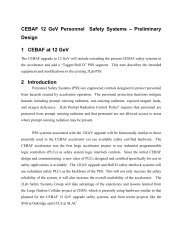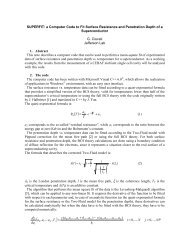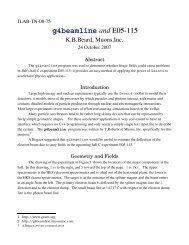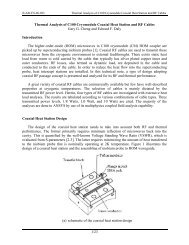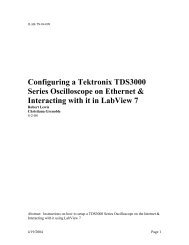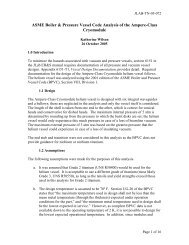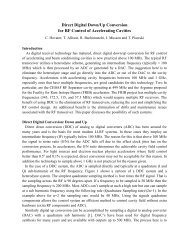Workshop on Polarized Electron Sources and Polarimeters
Workshop on Polarized Electron Sources and Polarimeters
Workshop on Polarized Electron Sources and Polarimeters
You also want an ePaper? Increase the reach of your titles
YUMPU automatically turns print PDFs into web optimized ePapers that Google loves.
Recent Progress toward Robust Photocathodes<br />
G. A. Mulhollan <strong>and</strong> J. C. Bierman<br />
Saxet Surface Science, Austin, TX 78744, USA<br />
Abstract. RF photoinjectors for next generati<strong>on</strong> spin-polarized electr<strong>on</strong> accelerators require photocathodes<br />
capable of surviving RF gun operati<strong>on</strong>. Free electr<strong>on</strong> laser photoinjectors can benefit from<br />
more robust visible light excited photoemitters. A negative electr<strong>on</strong> affinity gallium arsenide activati<strong>on</strong><br />
recipe has been found that diminishes its background gas susceptibility without any loss of near<br />
b<strong>and</strong>gap photoyield. The highest degree of immunity to carb<strong>on</strong> dioxide exposure was achieved with<br />
a combinati<strong>on</strong> of cesium <strong>and</strong> lithium. Activated amorphous silic<strong>on</strong> photocathodes evince advantageous<br />
properties for high current photoinjectors including low cost, substrate flexibility, visible light<br />
excitati<strong>on</strong> <strong>and</strong> greatly reduced gas reactivity compared to gallium arsenide<br />
Keywords: Photocathode, NEA, GaAs, Immunizati<strong>on</strong>, Photoyield decay, Amorphous silic<strong>on</strong>, FEL<br />
PACS: 85.60.Ha, 29.25.Bx<br />
INTRODUCTION<br />
The motivati<strong>on</strong>s for robust photocathodes are manifold. Ideal photoemitters would perform<br />
well under very poor vacuum c<strong>on</strong>diti<strong>on</strong>s. In practice, improved performance in<br />
operable vacuum is always desirable. It is well known that the envir<strong>on</strong>ment in RF guns<br />
is still tough <strong>on</strong> photoemitters, though designs incorporating better pumping represent<br />
good progress. High electr<strong>on</strong> spin-polarizati<strong>on</strong> photocathodes c<strong>on</strong>tinue to dem<strong>and</strong> ultra<br />
high vacuum (UHV) c<strong>on</strong>diti<strong>on</strong>s for reliable operati<strong>on</strong>. Better envir<strong>on</strong>mental immunity<br />
for these photocathodes is required for successful operati<strong>on</strong> in RF guns, such as could be<br />
employed for the ILC. Photocathodes operated in high average current injectors manifest<br />
cumulative damage which limits operati<strong>on</strong>al lifetimes.<br />
Photocathode envir<strong>on</strong>mental interacti<strong>on</strong>s may be viewed as stemming from either<br />
chemical reacti<strong>on</strong>s or charged particle fluence. The principal source for chemical reacti<strong>on</strong><br />
participants is the background gas. Electr<strong>on</strong> beam induced desorpti<strong>on</strong> can increase<br />
the quantity of these reactants. Several gas species, such as CO2,H2O<strong>and</strong>O2 are known<br />
to be harmful to the lifetime of negative electr<strong>on</strong> affinity (NEA) photocathodes[1]. Detrimental<br />
charged particle fluences at photocathodes are primarily composed of i<strong>on</strong>s. Low<br />
energy i<strong>on</strong>s, most likely in RF guns, generate atomic displacements near the surface <strong>and</strong><br />
can affect the activati<strong>on</strong> layer as well as the near surface crystal structure. This damage<br />
can be annealed out <strong>and</strong> the photocathode activated again to an NEA state. High<br />
energy i<strong>on</strong>s, such as found in DC guns can cause many displacements per particle if<br />
they impact the photocathode. The damage to the photocathode crystalline structure can<br />
be widespread <strong>and</strong> if the energy is large enough, the damage may not anneal out. Both<br />
high <strong>and</strong> low energy i<strong>on</strong> interacti<strong>on</strong>s can affect yield <strong>and</strong> the emitted electr<strong>on</strong> spinpolarizati<strong>on</strong>.



